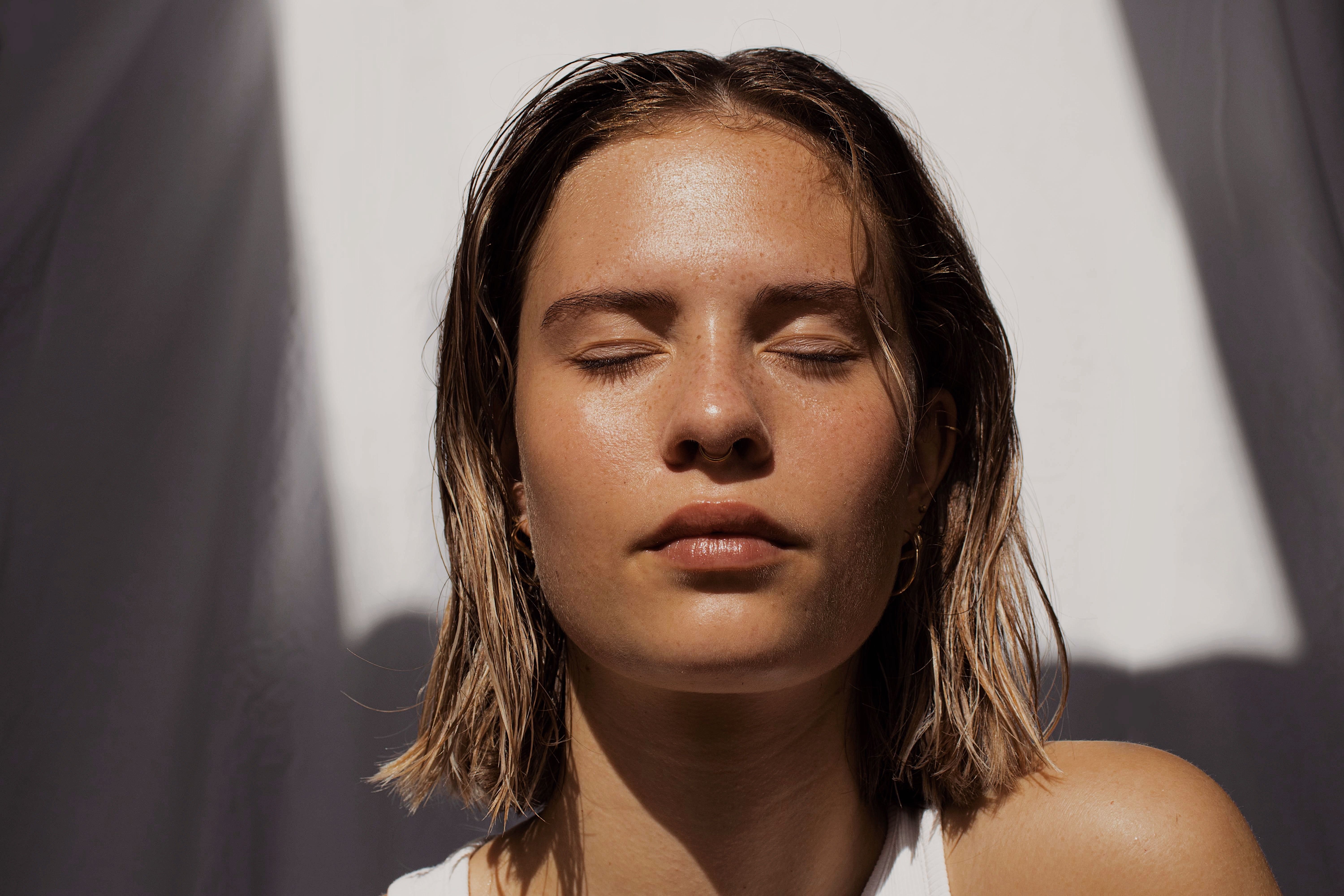
How To Care For Rosacea: Types, Symptoms, Causes, and Treatment
Rosacea is a chronic skin condition that typically affects the face and body. Familiarize yourself with the causes, symptoms, and possible treatments here.
By SunsolveMD Team | 7 Min. Read
January 2, 2023What is Rosacea?
It might just be ordinary redness. But if you notice recurring red flushing to your cheeks, bumps, or visibly spread blood vessels on your face, you might be experiencing a skin condition known as rosacea. The good news is that it is a common skin condition, and with the right care and treatment, most of us will be able to manage the symptoms and maintain clear, healthy skin. Although rosacea affects people of all skin colors it more commonly targets women with lighter skin types and develops between the ages of 30 and 50.
One of the most important things to do is to visit a board-certified dermatologist. Your dermatologist will be able to diagnose and recommend the best treatment for your specific case. Together, you can find a solution that works for you.
At the same time, there are some tips and tricks that help manage rosacea symptoms. For starters, it is important to avoid harsh skincare products and limit exposure to extreme temperatures. This can help to reduce the risk of flare-ups. Additionally, a healthy diet and lifestyle can also help manage rosacea.
It is good to be aware and educated about this condition as there are certain steps you can take to help avoid the risk of redness less and flare-ups. By caring for your skin, it can be managed effectively. With our comprehensive rosacea guide, you can familiarise yourself with its causes, symptoms, and possible treatments.
What Are Different Types of Rosacea?
Rosacea exists on a spectrum, with specific symptoms varying depending on the subtype. That's why classifying rosacea into 4 different categories will help you better understand the condition.
Here are the four subtypes of rosacea:
Erythematotelangiectatic (ETR) Rosacea
You may notice facial redness, flushing, and dilated blood. How it feels and looks on the skin: swollen or stinging and burning skin, dry, rough and scaly skin.
Papulopustular (acne-like breakouts) Rosacea
Often affects middle-aged women and makes the skin appear very red. How it feels and looks on the skin: visibly broken blood vessels.
Phymatous Rosacea
This subtype causes excess skin tissue growth that results in thickening skin and typically affects the nose, but it can also cause symptoms on the ears, chin, forehead, cheeks, and even eyelids. How it feels and looks on the skin: the pores look larger, skin is visibly thickened and irregular.
Ocular Rosacea
Centered on the eyes and eyelids, causing them to become red and irritated. How it feels and looks on the eyes: bloodshot and watery, dry and itchy or stinging sensation.
What Causes Rosacea?
We still cannot pinpoint the exact cause of rosacea because we need to take into account a complex interplay of triggers that vary from person to person. Although genetic or vascular factors are most easy to blame, we cannot exclude elements like the weakened immune system or environmental triggers.
Genetics
Certain genetic traits may predispose someone to rosacea. These include fair skin, light eyes, and a family history of rosacea.
Environmental Triggers
Exposure to hot or cold temperatures, sunlight, wind, or humidity can trigger rosacea flare-ups. Certain foods and drinks, such as spicy foods, hot beverages, and alcohol, can also cause rosacea to flare.
Underlying Skin Conditions
People with sensitive skin are more likely to develop rosacea. Other skin conditions, such as acne, seborrheic dermatitis, or eczema, can also increase the risk of developing rosacea.
Stress
Unfortunately, stress is a common component of our fast pace modern lives. Curbing stress is all about tracking its cause. If you experience a rosacea flare-up as a result of stress, try writing down the date, time of day, and how you feel at that exact moment. Mindfulness & meditation can positively impact the immune system, helping in treating inflammatory skin condition such as rosacea. Find what works for you.
With time and patience, you will figure out how to manage rosacea. Regardless of your dermatologist's treatment plan, remember that you are not alone and there is help available.
Prevention of Rosacea
Although rosacea cannot be cured, you can take steps to control the symptoms. We all know it starts with taking care of your skin. Avoiding harsh ingredients (alcohol and menthol) that may irritate your skin is key. Look for gentle cleansers and oil-free, water-based, and soothing skincare products.
While there is no specific rosacea diet, some food may help combat rosacea. Although finding the right nutrients requires trial and error there are common inflammatory foods to avoid and anti-inflammatory foods to try.
Foods high in healthy fats:
- Fish high in omega-3 (salmon, herring, sardines, mackerel, and lake trout),
- Certain nuts and seeds (walnuts, hemp seeds, flaxseeds, and chia seeds)
- Peanut butter
- Eggs
- Olive oil
Some recent studies show a link between inflammation and diseases of the gut. Many people experience rosacea together with gastrointestinal conditions. This connection suggests a link between inflammation of the gut and the skin. In light of this information, it has become increasingly important to focus on gut health.

Probiotic and prebiotic-rich foods:
- Certain cheeses
- Sauerkraut
- Miso
- Kombucha
- Kimchi
Avoiding Direct Sunlight and Wearing Sunscreen
Rosacea will cause your skin to flush more easily, resulting in redness, sensitivity, and uneven texture. That means it is more exposed to UV damage, so it is essential to find an SPF formula that protects without irritating.
Free from fragrance and chemical filters, SunsolveMD Anti Rosacea formula is designed with sensitive and rosacea prone skin types in mind.
A lightweight and gentle sunscreen leaves zero white cast and can easily slot into your existing skincare and makeup routine.
Since one of the hallmarks of rosacea is that it weakens the skin barrier, SunsolveMD Anti Rosacea is packed with antioxidant ingredients to provide long-term relief from skin redness and irritation by visibly restoring and balancing the skin's complexion.
The next-generation mineral SPF is packed with anti-inflammatory ingredients
Milk protein
Nourishes the skin with anti-irritant and protective properties. Fortifies the skin with amino acids that leave the skin feeling plump, cushiony, and moisturized.
Oat Kernel Extract
Supports the calming and UV-protective effects of zinc oxide by soothing the skin while providing a powerful antioxidant effect.
Plankton Extract
This small but potent micro algae source contains highly nutritious minerals, vitamins, enzymes and proteins. Protects, repairs, and replenishes the skin complexion while reducing redness.
TheSolveTM
Patented zinc (non-nano) technology provides a broad-spectrum SPF 50+ and shields the skin from 98%+ of UV radiation.
Niacinamide
This powerhouse form of vitamin B helps renew and restore the surface of dry skin against moisture loss and dehydration. Calming niacinamide decreases the redness associated with rosacea.
Hyaluronic acid
A highly moisturizing and gentle ingredient helps rosacea prone skin to draw and retaining moisture. Plumps up skin cells for a healthy glow and improves skin elasticity.

How Can I treat Rosacea?
Your doctor will be able to prescribe the treatment based on your specific symptoms. There are many treatments available for those with rosacea, including topical creams, antibiotics, and laser treatments.
Topical Medications
Mild-to-moderate rosacea can often be treated with topical prescription medications. There are several topical medications that can make living with rosacea easier: metronidazole, ivermectin, niacinamide, azelaic acid, and sulfur.
Oral Medications
A type of oral antibiotic such as doxycycline carries anti-inflammatory benefits and is an effective treatment for an ocular type of rosacea.
Laser therapy
Vascular lasers and intense pulsed light devices work by targeting hemoglobin in the blood vessels responsible for the flushing and blushing phenomenon, thereby reducing redness.
Mineral Zinc Oxide Sunscreens
Sun exposure was named a top trigger for rosacea flare-ups by 81 percent of patients in a National Rosacea Society2 survey. That's why it's so important to protect yourself against UVA and UVB rays all year round. A mineral SPF formula designed for sensitive skin can help reduce the possibility of irritation.
The National Rosacea Society advises to apply sunscreen 30 minutes before going outside, so it has time to absorb into the skin, and reapply it at least every two hours after swimming or sweating. Remember that ideally, you should limit your sun exposure, especially between the hours of 10 a.m. and 4 p.m. when the sun is strongest.
References
Daou, H., Paradiso, M., Hennessy, K. et al. Rosacea and the Microbiome: A Systematic Review. Dermatol Ther (Heidelb) 11, 1–12 (2021). https://rdcu.be/c2q5A
https://www.rosacea.org/patients/skin-care/sunscreen-for-rosacea
Holmes AD, Spoendlin J, Chien AL, Baldwin H, Chang ALS. Evidence-based update on rosacea comorbidities and their common physiologic pathways. (2018). https://pubmed.ncbi.nlm.nih.gov/29089181/
